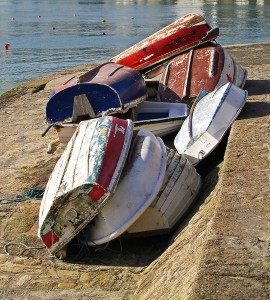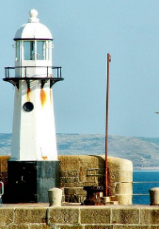
Rowing boats on St Ives Harbour
There's so much we could tell you about the fine golden sands and the clear blue ocean, the way the sunlight flickers over the cottages and quays, about the galleries, the gardens, the cafes and restaurants.
Would you like to know about the ancient sites and stones, the famous people and buildings? We could tell you how easy it is to travel here and how Cornwall's wonders are all close by.
St Ives, the most famous of Cornish holiday towns, loved for generations, is easy to reach by road or by air and easy by train, too, along one of the most spectacular railway journeys in Britain to crystal blue waters, golden sands and a warm welcome. We nearly forgot the mild sub-tropical climate, warmed year round by the Gulf Stream!
Life here is cradled around the harbour where boats still land good catches of freshest fish for the local restaurants to nourish you with. Brought ashore on the ancient granite quays, the catch is of the highest quality for your dinner plate or for the tables of some of Britain's finest restaurants. A maze of tiny cobbled streets to wander through, lined by fishermen's cottages, with a breathtaking seaside vista to greet you at the end of each one.
 St. Ives have won the 'Britain in Bloom' competition many times and several European titles too. There's a blaze of colour all around the town: houses smothered in baskets of blooms, parks and public areas a rich spectrum of radiant colours. Our mild climate and almost frost-free winters makes it possible to grow plants and shrubs normally native to semi-tropical countries hundreds of miles further south. Try us for a winter break in Cornwall!
St. Ives have won the 'Britain in Bloom' competition many times and several European titles too. There's a blaze of colour all around the town: houses smothered in baskets of blooms, parks and public areas a rich spectrum of radiant colours. Our mild climate and almost frost-free winters makes it possible to grow plants and shrubs normally native to semi-tropical countries hundreds of miles further south. Try us for a winter break in Cornwall!
Take a leisurely walk along the coastal footpath, perhaps, south to Lelant with the opportunity to return by branch line train or opt for a more energetic hike west towards Zennor and Gurnards Head. Soak up the sounds and images of the mythical and rugged land. Paint, pencil and clay. St Ives is renowned for its art and rightly so as there are workshops, studios and galleries everywhere. Often you will find painters hurrying to finish a sketch before the light changes or before the waves wash their palettes away!
Did you know?
- It remains an undisputed fact that Cornwall, once a separate country, has never formally been integrated into England, which is why some even today still believe that Cornwall and England are technically two distinct countries – they maintain that it takes a specific Act of Parliament to merge the two countries, as opposed to merging them by stealth.
- Cornwall showed a very different type of settlement pattern than Saxon Wessex. Places continued (even after 1066) to be named in the Celtic Cornish tradition not Saxon tradition and Saxon architecture is very rare in Cornwall.
- Many maps of the isles prior to the seventeenth century showed Cornwall as a nation on a par with Wales, notably the renowned 16th century German and Flemish cartographers Gerardus Mercator, Sebastian Munster and Abraham Ortelius.
- Cornwall was portrayed on numerous maps, including the famous Mappa Mundi, as separate from England right up until the mid 16th Century and Henry VIII even listed England and Cornwall separately in the list of his realms given in his coronation address.